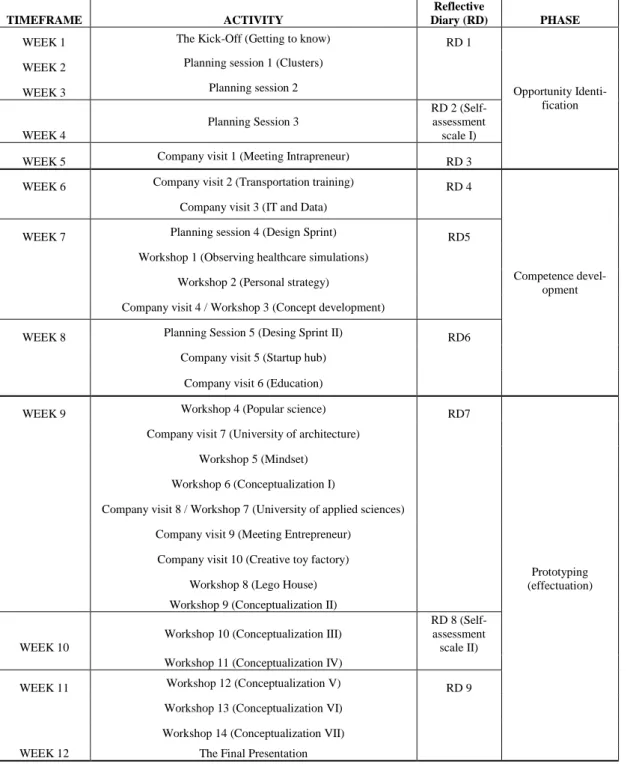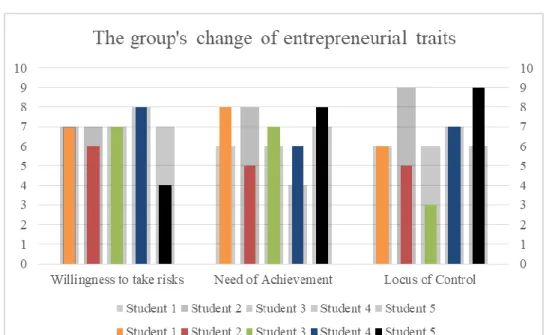The theoretical framework of this study was based on scientific literature related to the theory of entrepreneurship and the value creation process of entrepreneurs, including the theories of entrepreneurial traits and self-directed learning. The business process in this case study was divided into three phases – opportunity identification, competency building and prototyping. Due to the scope of a bachelor thesis and the uniqueness of this case study, this thesis only provides an overview of the process of value creation for entrepreneurs as a learning experience.
Theory of Entrepreneurship
Although no longer a new phenomenon, systematic research on entrepreneurship is still considerably recent. As a business discipline, it was built by adapting theories and conceptual work from different scientific fields such as sociology, psychology, anthropology, management, organizational behavior and engineering (Kuratko, D. F., Morris, M. H., & Schindehutte, M., 2015).
Entrepreneurial intention
Entrepreneurial opportunity
Entrepreneurs find gaps in technology, demographics, markets, government policies, and other factors—objective, actor-independent circumstances—on which they build their entrepreneurial opportunities using the effectuation method (Stritar, R., & Drnovsek, M., 2016). The opportunity is then exploited by the resources the entrepreneur has at hand and additional necessary resources are acquired (Mishra C. S. & Zachary, R. K, 2015).
Entrepreneurial competence
On the other hand, entrepreneurs who accept the ability to set and achieve goals through their own actions, according to Kobia M., & Sikalieh D. 2010), are more likely than the general population to create successful enterprises. On the other hand, entrepreneurs with a high need for achievement, strong internal locus of control and less risk aversion are more likely to see opportunities where others would see threats (Kobia M., & Sikalieh D., 2010).
Metacognition and Self-directed learning
In contrast, formal entrepreneurship education is typically concerned with the entrepreneur's ability to create and successfully manage a business so that the entrepreneurial activity contributes to the economy (Trivedi R. H., 2013). From this perspective, entrepreneurship is seen as a catalyst in the economy that increases prosperity and adds jobs, while formal entrepreneurship education is more oriented towards economic development (Trvedi R. H., 2013).
Entrepreneur’s social networks
According to Qian, X., Xu, W., & Li, K. 2010), the quality of the entrepreneur's social network has a strong impact on their company's performance and growth potential, because the entrepreneur is the liaison body that connects the companies with the external environment. 2019) observes that entrepreneur's social network arises from their social skills and the ability to develop and maintain interpersonal connections. Using their social network enables entrepreneurs to obtain resources at a lower cost, reduces uncertainty and information gap (Qian, X., Xu, W., . & Li, K., 2010).
Appropriation of entrepreneurial reward
Entrepreneurship and Enterprise
This thesis explores the phenomenon of entrepreneurship and how it is reflected in the experiences of students participating in the course "Creating Life Skills at Work in an Entrepreneurial Environment", which was developed at Arcada University of Applied Sciences and is therefore a case the only study. . Thus, this case study is based on grounded theory methodology and aims to observe and explore how the phenomenon of entrepreneurship has appeared in the unique learning experience offered in the mentioned course, through inductive data collected in the form of reflective diaries . self-rating scales, researcher observations and an interview with the course initiator.
Research Design
It also describes the research sample, its selection and the informed consent of the participants. A weekly summary of all reflective journals collected over a week was also established, and all weekly summaries were compared in chronological order to observe the development of a generalized learning experience over the course.

The case
In addition, data from the reflective diaries were supported by the researcher's participatory observations, the self-assessment scale and the interview with the course initiator (see Figure 1).
The Sample
Data collection and analysis
In this thesis, the researcher's brief observations regarding the premises and activities of the subject were continuously documented, as the researcher participated in the subject's activities. Participant observation is a data collection method that results from the researcher's immersion in his target group (Bryman & Bell, 2015). A focused interview was conducted with the initiator of the course “Creating skills for working life in an entrepreneurial environment” to gather additional information about the course such as purpose, structure, outcomes, etc., due to the uniqueness and novelty of the course. of this course, this information was otherwise not available to the researcher.
Focused interview, according to Bryman and Bell (2015), is a prominent data collection strategy for using predominantly open-ended questions that ask informants about a specific situation or event that is important to them and falls within the researcher's field of interest.
Informed consent
A course overview was conceptualized by the researcher based on his observations regarding the time frame and related activities within the course path. The course timeframe was divided into nine sections, represented by nine reflective diaries written by the course participants. In this thesis, the course overview (see table 1) functions as a visual representation of the course structure developed by the students.
Since the students have developed their own course structure, it is seen as an entrepreneurial process, and the course activities are then divided into three phases based on the entrepreneurial value creation process – opportunity identification, competence building and prototyping.

The description of the course
- The intention
- The framework
- The participants
- The expectation
Based on the selected skills, the group of students is then divided into smaller working groups - groups. The course organizer said – “The course participants show a wide variety of multicultural and multidisciplinary groups, which the whole school is <…> we [the organizers] wanted to have as wide a spectrum of students as possible <…> to create something that appeals to as many students as possible". At the end of the course the concept of the newly developed learning environment would be presented to the stakeholders, ie.
By participating in the course and working on concept development, students were expected to have developed their chosen skills and gained important knowledge relevant to working life.
The Reflective Diary
- Reflective Diary 1
- Reflective Diary 2
- Reflective Diary 3
- Reflective Diary 4
- Reflective Diary 5
- Reflective Diary 6
- Reflective Diary 7
- Reflective Diary 8
- Reflective Diary 9
The reflective diary 2 concludes the students' learning experiences during the fourth week of the course. The third reflective diary concludes the students' learning experiences during the fifth week of the course. The fifth reflective diary concludes the students' learning experiences during the seventh week of the course.
The students wrote: “The [workshop 8] was excellent, again too little time to see and explore and be creative and let your inner child come out.
The Entrepreneurial Traits
The change can be noticed in the self-assessment of two students, whose risk-taking ability has weakened by the end of the course. Four out of five students experienced a slight increase in their performance needs at the end of the course, while one student experienced a decrease in their trait by almost half. Also the internal locus of control property within the group has changed at the end of the course.
One student experiences a 3-point increase in their internal locus of control, suggesting that they felt more in control of their daily reality at the end of the course than at the beginning of the course.

Opportunity identification
The summarized findings from the reflective diaries were then attributed to the entrepreneurial value creation phases, demonstrating how the entrepreneurial process was applied by the students to create their own learning environment. These feelings were attributed by the students to the lack of structure and direction within the course. Great significance was attributed by the students to the lively social environment that existed within the course.
The course activities in weeks 4 and 5 were completed by the students in the second and third reflective diaries, which revealed that the majority of students continued to feel confused and uncertain about their role in the project.
Competence building
According to Cox K. (2016), seeking more information about the entrepreneurial opportunity helps entrepreneurs to conclude whether that opportunity will be viable or profitable. to gain more confidence and clarity about the path of the course. Another factor that positively influenced the learning experience in the course was the mindset within the course group, where everyone seemed equally interested in developing the project and learning new skills. 2016), entrepreneurship requires a metacognitive capacity to understand, control and reflect on one's own learning process. In addition, the exuberant social environment also played an important role throughout the learning process of the whole group, where the uncertainty and confusion experienced by students could gain insights and inspiration from their fellow students, who managed to develop some competences at an earlier stage; the students were also able to combine insights they had previously gained from their studies within different disciplines. 2019), a set of well-developed social skills supports the development of entrepreneurs' social networks and enables them to better adapt to different social environments, while also facilitating better relationships with other people.
By using their social network, entrepreneurs also obtain resources at a lower expense and are able to reduce the uncertainty and information gap within their environment.
Prototyping
During the week, the students generally felt confident as a result of the lively social environment within the group. Guided by the course's intent and guided by their coaches, the students tried to identify possible opportunities for the development of the new learning environment. The entrepreneurial concept development was initially experienced by the students with the feelings of confusion and.
Coming from different disciplines and belonging to different demographics, the students created a lively social environment within the course.
Shortcomings and future recommendation
Taking advantage of this lively social environment was attributed by the students as an important factor that enabled them to overcome feelings of confusion and complete their project.
Trustworthiness of the thesis
Participant observation: a methodology for humanities studies Towards a search for the meaning of entrepreneurship", Journal of European Industrial Training, Vol.
At the end of the course the student is expected to - be able to understand and apply the concept of internal and entrepreneurial thinking - understand the lean and agile process and concept development - fully understand the concept of lifelong learning - be able to critically evaluate and reflect on his/her learning - be able to understand and apply the concept of creativity - build and evaluate networks - increase his/her skills for working life - to learn teamwork and team building skills in multidisciplinary teams. NOTE: you can enroll in the course after you have been accepted into it. Students who participate in this course will receive pass/fail grades and the course is worth 5 etc.
To pass the course, the student must participate in the following: Study and concept development field trip(s) Successful participation in team collaboration.
